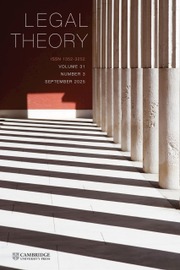Owing to editorial errors in the article by Mullins,Footnote 1 angled brackets have been misplaced in several formulae. The sentences in question follow:
• For any case c = 〈X, r, s〉, Factors(c) = X, Rule(c) = r and Outcome(c) = s.
• In order to ensure coherence, we stipulate that for any case c = 〈X, r, s〉 belonging to a case base Γ, Premise(r) ⊆ X s.
• Suppose the court reasons against the background of a case base Γ1 that contains only one case, c 1 = 〈X 1, r 1, π〉.
• In a new fact scenario X, a decision in X based on the rule r and leading to outcome s will satisfy the protected reason model of precedential constraint just in case Γ∪
 ${\lcub〈{X}\comma \;{r}\comma \;{s}\;〉\rcub}$ is exclusion consistent.
${\lcub〈{X}\comma \;{r}\comma \;{s}\;〉\rcub}$ is exclusion consistent.• Adding the case c 2 = 〈X 2, r 2, δ〉 to Γ1 would introduce inconsistency into the case base because we could then derive the priority relation
 $\lcub {f_1^\pi \comma \;f_2^\pi \comma \;f_3^\pi } \rcub \lt _{c_2}\lcub {f_1^\delta } \rcub $, which is inconsistent with the priority order
$\lcub {f_1^\pi \comma \;f_2^\pi \comma \;f_3^\pi } \rcub \lt _{c_2}\lcub {f_1^\delta } \rcub $, which is inconsistent with the priority order  $\lt _{c_1}$.
$\lt _{c_1}$.• A case base Γ is exclusion consistent just in case there is no case c = 〈X, r, s〉 in Γ such that for another case
 ${c}^{\prime} = 〈{X}^{\prime}\comma \;{r}^{\prime}\comma \;\bar{s}\;〉$ in Γ,
${c}^{\prime} = 〈{X}^{\prime}\comma \;{r}^{\prime}\comma \;\bar{s}\;〉$ in Γ,  ${X}^{\prime}\,{\rm \models }Premise\lpar r \rpar $ and Premise(r ′) ∈ Excluded c.
${X}^{\prime}\,{\rm \models }Premise\lpar r \rpar $ and Premise(r ′) ∈ Excluded c.• Supposing that the decision for defendant in this case is represented by the case c 5 = 〈X 5, r 4, δ〉,
 ${\rm \Gamma }_1\cup \lcub {c_5} \rcub $ will not be exclusion inconsistent.
${\rm \Gamma }_1\cup \lcub {c_5} \rcub $ will not be exclusion inconsistent.• To illustrate the equivalence between the two approaches we can return to the same example of a case base Γ1 involving the previous decision c 1 = 〈X 2, r 1, π〉, where the decision-maker is as before faced with the new fact scenario
 $X_2 = \lcub {f_1^\pi \comma \;f_1^\delta } \rcub $.
$X_2 = \lcub {f_1^\pi \comma \;f_1^\delta } \rcub $.• To illustrate this, consider a case base Γ2 involving the two cases introduced above, c 1 = 〈X 2, r 1, π〉 and c 3 = 〈X 3, r 1, π〉, recalling that
 $X_1^{\bar{\pi }} = \lcub {f_1^\delta } \rcub $ and
$X_1^{\bar{\pi }} = \lcub {f_1^\delta } \rcub $ and  $X_3^{\bar{\pi\; }} = \lcub {f_2^\delta } \rcub $.
$X_3^{\bar{\pi\; }} = \lcub {f_2^\delta } \rcub $.• Instead the judge rules for the plaintiff, with the ruling represented by case c 6 = 〈X 2, r 1, π〉 because they take
 $\lcub {f_1^\delta } \rcub $ to be excluded from being a reason for ruling for the defendant.
$\lcub {f_1^\delta } \rcub $ to be excluded from being a reason for ruling for the defendant.• It follows from (5) and Definition 4 that where c = 〈X, r, s〉 , (7)
 $P\subseteq X^{\bar{s}}$ and (8) Premise(r)⊆ Q .
$P\subseteq X^{\bar{s}}$ and (8) Premise(r)⊆ Q .
We regret the errors.


